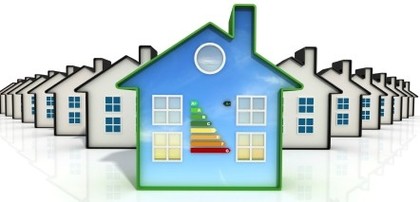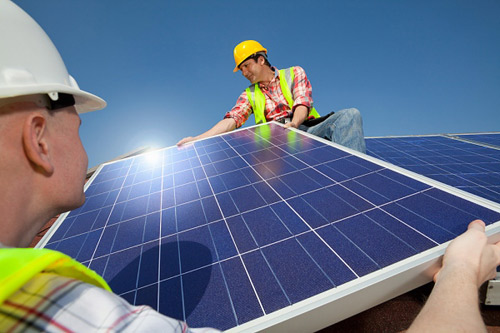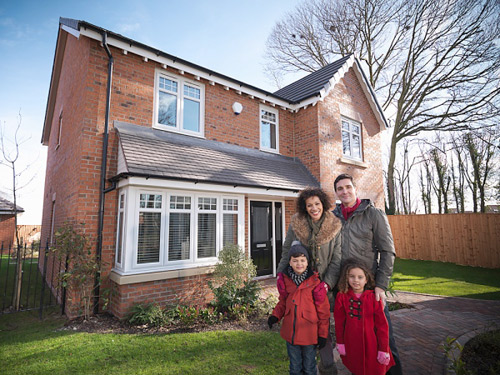The Green Deal Scheme
How does the Green Deal Scheme work?
The scheme is driven by the need to be consumer-led, so making the energy efficiency property improvements attainable is the essence of the scheme. The Green Deal allows property owners to finance the appropriate measures and improvements to make their property more energy efficient, with no up-front cost. The repayment for the work carried out will then be covered by the savings made on the property’s energy bills. The process has four main steps:
- Step 1: The Energy Assessment - Green Deal Advisor (GPA)
- Step 2: Finance - Green Deal Provider (GDP)
- Step 3: Installation - Green Deal Installer (GDI)
- Step 4: Repayment - Via your Energy Supplier
STEP 1: Getting An Assessment

The Green Deal assessment is the first and most crucial step in the Green Deal process. The assessment will provide impartial information to determine suitable measures that would provide improvement to the energy efficiency of the property.
The assessment includes producing an EPC (Energy Performance Certificate) with an Occupancy Assessment which together form the Green Deal Advice Report which outlines the suggested measures that should be installed in order to increase the energy efficiency of the property. The savings expected to be yielded from these measures will also be calculated to ensure that they would meet the criteria of ‘The Golden Rule’.
These two documents will not only give details of the energy performance of their property as it stands after the initial visit, but will form the basis of the Green Deal Plan – the measures being offered to help reduce the households fuel bills.
Elements of the revised EPC include:
- Recommendations and Golden Rule based on standard occupancy
- Regional weather (degree days) for cost saving calculations
- Actual U-values where evidence supports
- Additional recommendations (annually refreshed)
- Additional measures modelled (roof insulation, heat recovery, heat pumps etc..)
- Partial installations, room by room
- Occupancy assessment to show effect of current lifestyle on standard savings
- The Occupancy Assessment – requiring the input of:
- Occupant numbers
- Number of Showers/Baths
- Heating Systems, patterns & temperature
- Freezers & Fridges
- Driers
- Appliances
This assessment allows the householder to look at EPC recommendations and select one
or more of the scenarios for comparison. The Occupancy tool then calculates the savings based on the standard RdSAP assumptions and the entered occupancy figures.
If the assessor wants to quote for improvements or recommend products or providers, they must get your permission before the assessment.
STEP 2 - Select a Green Deal Provider

Consumers will be free to finance work as they wish, and some people may opt to pay for the work upfront, in whole or in part. But, uniquely, the Green Deal offers the opportunity to repay through energy bills, spreading the cost and enabling the obligation to repay to be passed on to future occupiers.
The key principle, or golden rule, for accessing Green Deal finance is that the charge attached to the bill should not exceed the expected savings, and the length of the payment period should not exceed the expected lifetime of the measures. This is not a government guarantee, but a guideline for customers that, typically, they should be able to expect to gain more efficient, less wasteful properties with no additional net cost from the Green Deal.
You will contact a Contact a Green Deal provider to discuss what work is right for you. The key role of the Green Deal provider is to offer a Green Deal plan to customers to finance work which is recommended by an accredited adviser and undertaken by an accredited installer.
The Green Deal provider would consider the package of measures and make an offer which stipulates the total cost, the charge to be attached to the energy meter, and the length of the repayment period. This should be in line with the objective recommendations provided by the qualified Green Deal adviser, and only approved measures installed by qualified Green Deal installers will be eligible for finance attached to the energy meter in this way.
Both owners and occupiers of a property will be able to take out a Green Deal, however they will
need to obtain consent from all relevant parties that have an interest in the property (this may
include the freeholder) ahead of any measures being installed. In cases where the applicant and the energy bill payer are different, the express consent of the current energy bill payer will be required. In the case of rented properties the tenant would need to obtain the express written consent of the building owner before proceeding with the Green Deal plan.
Whilst not a loan, A Green Deal plan attached to the energy meter at a property which has been entered into by an individual or small business is likely to count as a fixed-term credit arrangement, and therefore fall under the protection of the Consumer Credit Act (CCA) 1974. This means that Green Deal providers will need to be certified with a Consumer Credit Licence from the Office of Fair Trading before they can operate, and will therefore be regulated in their
activities.
Most improvements should reduce your heating bill because you’ll be using less electricity, gas or oil - but the actual savings depend on your energy use and the future cost of energy.
Before you sign your Green Deal Plan, check you understand the repayment rules.
The advantage of the Green Deal is that it enables consumers to fund energy efficiency improvements from the value of savings generated throughout the payback period. Because some payback periods may last several years after the investment, consumers will need to pay interest on this money. The golden rule must hold for the total cost of the work (including the measures, labour costs and financing costs) so keeping financing costs to the absolute minimum will be fundamental to the Green Deal’s success.
STEP 3: Installation

Once finance for measures has been approved, installation is the next step. The Green Deal is designed to provide trusted, accredited installation of energy efficiency measures to households and businesses. Certification of installers is an essential element of this, as work will be undertaken by a range of tradespeople. The standards and certification framework will ensure that all work is completed to a recognised standard and that consumers can expect the same level of customer care and protection regardless of the installer.
Certified installers will be backed by an official quality mark, designed to allow consumers easily to identify Green Deal service providers.
The installers will be paid directly from the Green Deal Provider...No Payment Is Required Up Front
STEP 4: Repayment and Benefits

One of the key features of the Green Deal is that the consumer repayments come through a charge on the energy bill. It is important that the Green Deal charge can be recouped in the same way as any other part of the energy bill to ensure simplicity for the customer, and so that finance providers have the confidence to provide the upfront capital, secure in the knowledge that they will receive payments via energy suppliers.
When the Green Deal installer has completed the work, they will inform the Green Deal provider who will arrange for details about the Green Deal to be included in an updated EPC or other appropriate document and lodged on the EPC database. The Green Deal provider would also pass the relevant details to the customer’s energy supplier. Following verification by the energy supplier, which would give the customer the right to query any details, the Green Deal charge would appear on the next energy bill received by the customer. Customers with a Green Deal charge on the energy bill will still be able to switch energy suppliers.
At the end of the repayment period, the Green Deal charge will automatically be removed from future energy bills. If you have a prepayment meter, a small amount will be taken from the meter each day instead. You can pay off your Green Deal early, but you might be charged a fee - check with your provider.
If you move into a property with a Green Deal, the landlord or seller must show you a copy of the Energy Performance Certificate - this will explain what improvements have been made and how much you’ll need to repay.
The person who pays the electricity bill pays the money back - so if you’re a tenant in a rented property, you’ll be paying back the costs, not the landlord. This is because the tenant can expect to benefit from lower energy costs.
You can change electricity supplier, but only if the new supplier is participating in the Green Deal.
You will start reaping the benefits of the energy saving measures as soon as they have been installed.
Next: What Measures are included in the green deal